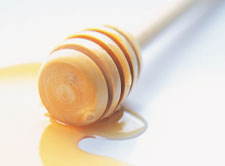Added sugars
by Nick Rose, M.S., PCC Nutrition Educator
This article was originally published in August 2011

Is there a recommended amount of sugar not to exceed daily? Does it matter what type of sugar I eat?
There are two types of “sugars” in our food: natural sugars found in fruits, some vegetables (like beets) and milk, and added sugars, including table sugar (sucrose), corn syrup, honey and maple syrup. Americans consume an average of 16 percent of their total daily calories in the form of added sugars. Almost half of added sugar intake comes from sugar-sweetened beverages.
A sensible recommendation for added sugar intake is five percent of total calories, the upper intake level recommended by the American Heart Association (AHA). The AHA recommends no more than 100 kcal per day for a 2,000 kcal diet. A 12-ounce can of soda contains 136 kcal from added sugars!
Spoonful for spoonful, honey contains 18 percent less sugar than common table sugar without tasting any less sweet. This is because the “sugars” in honey are fructose and glucose, which produce a higher sensation of sweetness than sucrose. The nutritional benefits get even sweeter when you consider honey contains a long list of nutrients, while table sugar is just empty calories. Honey’s amber color comes from flavonoids, the same class of antioxidants found in berries, citrus fruits, tea, wine and dark chocolate.
The specific nutrients found in honey depend on the floral origin (blueberry, clover, fireweed, manuka, wild flower). Darker varieties of honey (such as buckwheat) generally offer higher levels of flavonoids. Raw honey offers immune-boosting benefits.
Swapping honey for common table sugar at the coffee bar or on top of your breakfast cereal will increase your daily antioxidant intake, reduce your added sugar intake, and still taste just as sweet.
